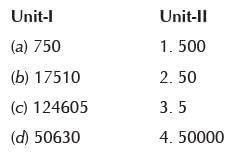Olympiad Test: Number Sense - Class 5 MCQ
20 Questions MCQ Test Math Olympiad for Class 5 - Olympiad Test: Number Sense
What is the predecessor of the greatest six-digit number?
What is difference between the place values of two 5’s in the number 4598351?

Which of the following signs can be placed in the box between the two numbers?

How many three-digit numbers can be formed with the digits 3, 0 and 7 without repetition?
Which are the respective greatest and the smallest numbers amongst 321987, 319240, 321978 and 321970?
What is the difference between the greatest and smallest 5-digit numbers formed by using all the digits 3, 0, 9, 1 and 5?
How can the number fifty million twenty-one thousand two hundred thirty six be written using commas according to Indian system of numeration?
How can the numbers 10 million, 1 billion and 216 thousand be arranged in descending order?
The number 24 is to be written as a product of its prime factors. Which one of the following is correct?
The number 90 is to be written as a product of its prime factors. Which one of the following is correct?
Match the following numbers in list I with the corresponding place value of number 5.


|
32 videos|57 docs|45 tests
|





 2,357,799
2,357,799















